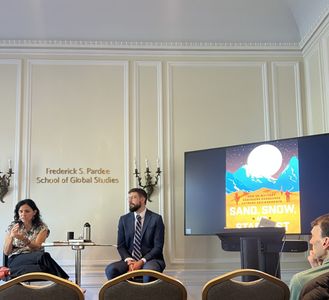Global Security Series Hosts A Stellar Panel on US Military Power in Extreme Environments
Written by Deniz Oray, Pardee School of Global Studies, Dean’s Ambassador (BAIR’26)

On October 21st 2025, the Pardee School of Global Studies, alongside Boston University’s History Department, had the utmost pleasure in hosting Professor Gretchen Heefner, Chair of the History Department at Northeastern University, to discuss her recent book Sand, Snow, and Stardust. Accompanied by Professor Benjamin Goossen of Pardee School of Global Studies at Boston University, the conversation followed a discussion format, followed by a question and answer session, focusing on how United States’ military engineers conquered extreme environments during the World War II and mid-Cold War eras.
While discussing how U.S. military power in conquering extreme environments such as deserts and the arctic became the centerpiece for her book, Heefner stated how the global maintenance of U.S. military power, particularly through increasing 14 military bases to thousands during the war, sparked her interest. The book therefore traced the work of military engineers in the sixties and how they accumulated environmental intelligence, which led to the development of bases in North African contexts such as Libya, Arctic spaces like Greenland, and beyond. Heefner mentioned how sand in particular posed a grave issue for the U.S. military in North Africa, which elevated her research on making sense of places that have a lot of materials, but no infrastructure. She further emphasized how her focus was on the aspect of continuity through deducing how people reformulate their idea of the environment and the place they live in.
Heefner argued that World War II’s Operation Torch—the Allied landings in North Africa—triggered the need for in-depth knowledge on extreme environments. In anticipation of passing the Mediterranean to reach Egypt and Libya, General Dwight Eisenhower expressed curiosity on the weather conditions in North Africa, leading to the collection of data from runways, reports with sand archives, accumulating data on the world’s environment, and how this all connected to intelligence and international security.
Sand, Snow, and Stardust introduced engineers who conducted experiments with devices such as copper mannequins acting as soldiers to ensure the process of standardization and militarization in the US military, while alternatively strengthening the concept of global environment and how it framing through research altered how people perceived it. Similarly, it shed light on the military’s ignorance on local practices, provided to the reader through the story of the Innuit population in Greenland, and how the U.S. military disregarded the indigenous population for the sake of building military infrastructure in the Arctic Circle with an environment difficult to survive in.
Additionally, Professor Goossen’s question on how the concept of “stardust” in the title developed, and how it depicted the “space race” between the U.S. and the Soviet Union, intrigued the audience; Heefner stated how the final part of her book was rather unexpected, and that next to the Greenland story, documents existed on lunar construction, in which engineers in 1962 were considering how to build a base on the Moon. The parallel institution structures for the Arctic and the desert through extraterritorial research centers, proving that this was in fact a military project operated by military personnel before the Apollo program started, affected how the last part of Sand, Snow, and Stardust developed.
Moreover, the audience posed interesting questions including how research on imperialism, colonialism, and the environment within the context of building these bases intersected with other knowledge gathering in the world, to which Professor Heefner responded with how bringing environmentalists’ conversations with American diplomatic history is imperative in understanding the subject matter. She further stated how the military was vital for postwar reconstruction in the U.S., and that all this abstraction of knowledge from local populations helped her question the characteristics of the settings which were deemed most vital.
Heefner finally touched on how the purpose of the book was to set down these military facilities and demonstrate a certain knowledge on how we can get anywhere whenever we want to, posing a threat and a warning to the global system of power. The way military structured environmental knowledge is important to see the development of environmental knowledge, how they co-exist, and to determine military intelligence and the detriments of it, all of which sum up Heefner’s book: Sand, Snow, and Stardust.